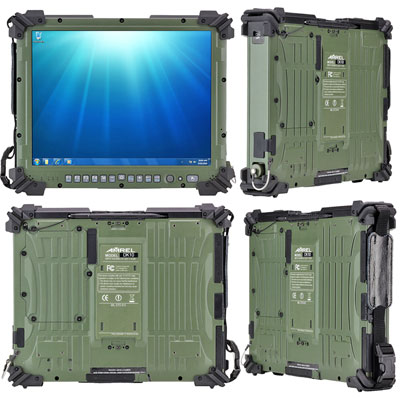|
AMREL DK10 Rugged Tablet PC
Rugged 12.1-inch tablet for military and industrial use receives substantial technology update
(by Conrad H. Blickenstorfer)
Based in El Monte, California, AMREL (AMerican RELiance) has a long history of offering value-added applications in vertical markets. The Rocky line of ruggedized computers was introduced in 1995 and has been updated, enhanced, and fine-tuned every since. This page covers the company's rugged 12.1-inch tablet computer.

The DK10 is a fully rugged tablet computer. It measures 12.2 x 10.0 inches inches and is 2.13 inches thick. It weighs 5.5 pound, quite reasonable for such a tough and heavily protected tablet. The aluminum housing sports a nice and purposeful industrial design. Easily replaceable rubber corner bumpers provide extra protection. The tablet is sealed to IP65 specifications, which means it's impervious to dust, and can also handle low pressure water jets from all directions. The unit is built both to MIL-STD 810G and MIL-STD 461E specifications for resistance to rain, shock, humidity, vibration, salt fog, altitude and extreme temperatures. A built-in heater allows operation in temperatures as low as -20°C/-4F.
As is always the case with AMREL computers, the DK10 offers very good expansion flexibility. There is an ExpressCard/54 slot, SD Card and SIM Card slots, and inside mini PCIe slots for expansion. Onboard connectivity consists of two USB ports (one USB 2.0 and one USB 3.0), a legacy DB9 serial port, a gigabit RJ45 LAN port, as well as docking and power ports. An optional "Docklight" stand/cradle adds four USB ports, audio in/out, and two serial ports and lots more. The touchscreen display is an 12.1-inch 1024 x 768 pixel XGA LCD with AMREL's sunlight readable anti-reflective technology. The primary Li-Ion battery packs 80 watt-hours; an optional secondary 80 watt-hour Li-Ion battery snaps onto the back of the device. This means significantly more battery power than almost any other tablet available.
Note that the ROCKY DK10 represents a significant technology update to the company's DK8 rugged tablet computer platform. The dated 1.06GHz Core 2 Duo chip of the older machine has been replaced with a much more powerful "Sandy Bridge" Intel Core i7-2610UE chip running at a base frequency of 1.5GHz and at up to 2.4GHz in turbo mode (see full i7-2610UE specs). Both base and maximum RAM has doubled, and it's now of the faster DDR3 variety. AMREL now offers either the 32-bit or the 64-bit version of Windows 7, and 64-bit can make a substantial performance difference (the DK10 can also run Windows 8). Both hard disks and optional solid state disks have been upgraded to SATA II standard. The default hard disk now runs at a faster 7,200rpm, and optional SSDs are available up to 256GB and more. On the wireless side, there is now faster WiFi via 802.11a/b/g/n, and that also includes Bluetooth 4.0. Gobi 3000 mobile broadband and uBlox GPS are optionally available. AMREL also mentions a brighter outdoor-viewable display, though that's not reflected in the tech specs.
As its DR predecessor, the DK10 comes in a black/gray industrial version or a specially configured NATO green military version with MIL-STD 461F compliance, metal twist lock Amphenol power jack, EMI ground Army option and more. AMREL proudly mentions that the DR10 is at Technology Readiness Level 9, the highest rating, meaning that the device and its technologies are fully mature and proven through successful mission operations (see Wiki on Technology Readiness Levels).
Compared to their 8.4-inch DR8 tablet, AMREL's DK10 offers significantly more screen real estate for improved legibility and ease-of-use, though the actual 1024 x 768 pixel resolution is the same. In this era of increasing display resolution, a high-res option would be nice.
Overall, while AMREL's rugged 12.1-inch DK10 tablet looks virtually identical to its DK8 predecessor, and that one to its predecessor (much of it mandated by compatibility and certification procedures), this latest model represents a major technology step forward in terms of much higher performance, significant additional functionality via Intel and other technologies, as well as incremental improvements in ruggedness and other areas.
|



